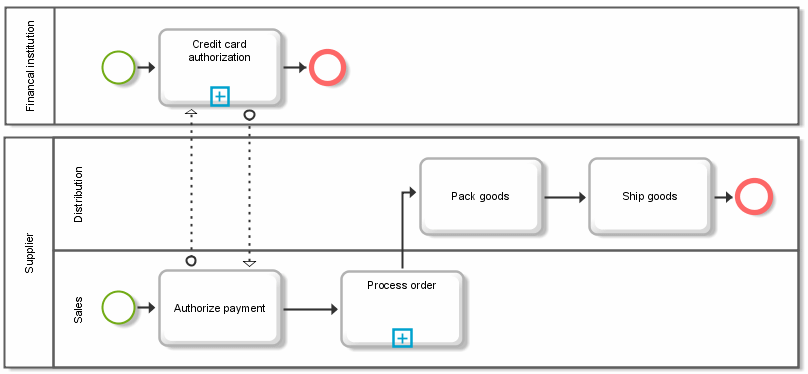Process classes and the business process diagram
Business Process Model and Notation (BPMN) uses the Business process diagram (BPD) model type for describing processes. This model depicts three classes of business processes and the relationships between them:
 Private business processes
Private business processes (internal business processes)
 Abstract business processes
Abstract business processes (public business processes)
 Collaboration processes
Collaboration processes (global business processes)
Private business processes are business processes that are performed exclusively within an organization. They are generally known as workflow or BPM processes.
Various internal business processes are modeled as a sequence flow within individual pools (see chapter
Implementation of BPMN in ARIS) whose interactions are represented using message flows.
BPMN uses the terms Sequence flow and Message flow instead of Control flow because the process is controlled not only by events, but also by the messages exchanged.
Abstract business processes describe interactions between private processes of different pools, between objects of different pools, or combinations of both. Besides the sequence flow within the private process, the message flow between the individual processes is particularly important. Interactions are modeled using message flows.
Abstract business processes are integrated in individual pools and can be modeled separately or as part of an entire BPMN diagram. If an abstract business process occurs in the same model as a corresponding private business process, they can be associated with each other.
Collaboration processes describe only interactions between two or more business entities (business associates). A sequence of activities is modeled to reflect the pattern of message exchanges between the various business associates. The sequence flow has no part in this.
Relevant languages for collaborations include bXML BPSS, RosettaNet, or W3C Choreography Working Group. The mapping specification is planned for later versions of the BPMN specification.
Collaboration processes can be integrated in pools. Interactions of the partners involved are described in individual lanes. This allows the processes to be modeled separately or as part of a comprehensive BPMN diagram. If a collaboration occurs in the same diagram as one of its internal processes, activities common in both can be associated with each other.
In turn, various types of business processes can be derived from the three process classes:

Private business processes at a higher level

Private business processes at a detail level (target or actual processes)

Processes running between detail processes and external entities

Processes running between detail processes

Processes running between detail processes and abstract processes

Processes running between detail processes and collaboration processes

Processes running between abstract processes

Processes running between abstract processes and collaborations

Processes running between collaborations

Processes running between multiple detail processes interacting through their abstract processes

Processes running between multiple detail processes interacting through a collaboration

Processes running between multiple detail processes interacting through their abstract processes and a collaboration
The following figure shows an example of a BPMN collaboration diagram with two business associates to which a separate process has been assigned. Both detail processes comprise a start event, activities, sequence flow connections, and an end event. Message flow connections are modeled between the activities of the two detail processes.
As processes of multiple business associates can be shown in one BPMN collaboration diagram and each business associate has a different view of the same process, it is useful to specify a 'point of view'. The BPMN does not dictate how the point of view is to be emphasized in a BPMN collaboration diagram. The easiest way is to specify the names of the assigned business entities (business associates) in the Description/Definition attribute (see the figure).
